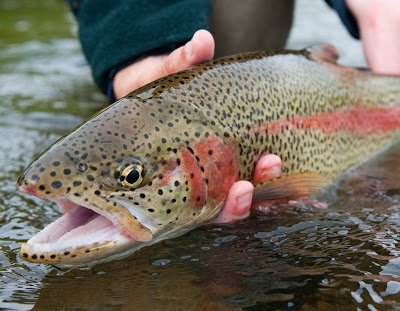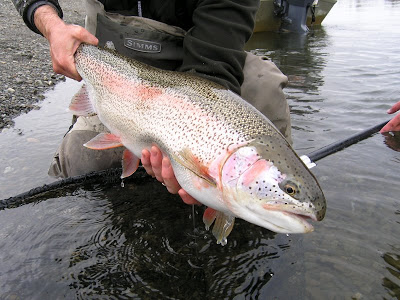
There are trout streams out there where highly educated trout demand perfect presentation. Long, light tippets are key. Pure, drag-free drift is essential, and if your fourth mend falls 3 inches left of where it should have, that fish is not going to eat.
The Kanektok is not one of those rivers.
Before we cover the techniques that work well on the Kanektok, let’s run through a bit of background on a Kanektok rainbow’s diet.
The rainbow trout that we target at Alaska West have a very short season during which they can eat. For most of the year, their food sources are all but shut down. From June to September, the short Alaskan summer arrives, and the salmon return.
The non-salmon food sources for Kanektok rainbows (mainly sculpins and small rodents) are more active during the summer months. More importantly, when the salmon enter the river and begin to spawn, the feast begins. Rainbows chow on salmon eggs as they wash downriver from spawning gravel. Once the salmon spawn and die, they break down and their flesh gets swept by the current…and the rainbows fill up.
During the summer, the river is loaded with food. The trout don’t have much time and the pickin’s are good, so they eat. And eat, and eat.
What does this mean for our techniques when we’re fishing for these pig rainbows? It means that it’s much more important to get your fly in front of as many fish as possible than it is to deliver a perfect presentation. For even the big, old trout, if they see it and it looks like food, they’re probably going to go for it. Don’t cast way upstream and mend, mend, mend to get the perfect drift– you will have missed a handful of good holding spots while you worked on that ideal presentation.
Hit the bank. Hit the dropoffs. Cover the snags. Hit each of the spots quickly and make a respectable but not necessarily perfect presentation. If he didn’t eat he wasn’t there, so move on.
Show your fly in a reasonable way to as many trout as possible, and you’ll have great success chasing rainbows on the Kanektok.

Leave a Reply